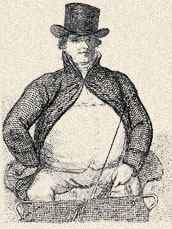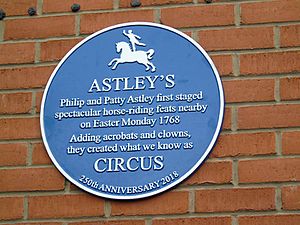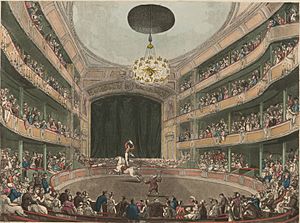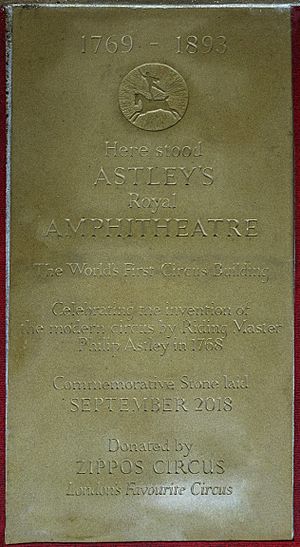Philip Astley facts for kids
Philip Astley (born January 8, 1742 – died October 20, 1814) was an amazing English horse rider, circus owner, and inventor. Many people call him the "father of the modern circus." The circus we know today, with its music, trained animals, acrobats, and clowns, began with Astley. He started a riding school in London called Astley's Amphitheatre in 1768. This was after he and his wife, Patty Jones, had great success with their trick-riding shows.
Astley and his wife put on their very first circus show on Easter Monday, April 4, 1768. They started with horse riding and added exciting sword fights. These early shows were held outdoors in a field in Lambeth, London. Astley performed his stunts in a round area. He called this area his 'Ride' or 'the Circle'. It was first 65 feet (about 19 meters) wide. Later, this size became 42 feet (about 13 meters), which is still the standard size for circus rings today.
From 1769, Astley moved to a more permanent place near Westminster Bridge. He added covered seats for the audience, making it more comfortable. In 1770, he hired acrobats, tightrope walkers, jugglers, and a clown. They performed during breaks in the horse acts. This mix of acts created the modern circus format that spread all over the world.
Contents
Philip Astley's Life Story
Philip Astley was born in Newcastle-under-Lyme, England. His father was a cabinetmaker. When Philip was nine, he started training with his father. But Philip dreamed of working with horses. So, at 17, he joined the army, becoming a Sergeant Major. During the Seven Years' War, he met many expert horse trainers and riders. Astley himself was a brilliant rider.
Becoming an Equestrian Master
Astley was incredibly talented at trick riding. He noticed that trick riders got the most attention from crowds. He had an idea to open a riding school in London. Here, he could also put on shows of amazing horse riding skills. In 1768, Astley performed in an open field in London. He soon added a clown to his shows to entertain people between the horse acts.
From 1769, he moved to a fenced area south of Westminster Bridge. He opened his riding school there and made his shows even bigger. He taught riding in the mornings and performed his "feats of horsemanship" in the afternoons.
Astley became very famous and wealthy. After two seasons, he needed new acts to keep people interested. So, he hired more horse riders, musicians, a clown, jugglers, tumblers, tightrope walkers, and even dancing dogs. This is how the modern circus was born! Before Astley, acrobats and clowns performed separately. Astley brought them all together into one big show where you bought one ticket for everything.
Astley did not invent trick riding; it was already popular. He also didn't invent the circular 'ring'. The round shape works well for two reasons. First, it helps the audience see the riders easily. Second, the circular ring helps riders stay balanced. This is because of something called centrifugal force when they stand on galloping horses. Astley never called his show a circus. That name was created by Charles Dibdin. Dibdin opened the Royal Circus in 1782 with Astley's rival, Charles Hughes.
After a few years, Astley added a platform, seats, and a roof to his ring. Even after he died, Astley's "Royal Amphitheatre" stayed famous for many years. Writers like Charles Dickens and Jane Austen even mentioned it. The Amphitheatre closed in 1893. Today, a garden of St Thomas's Hospital is on the site. A special stone marks where the Amphitheatre once stood.
Astley's first circus ring was 65 feet (about 19 meters) wide. Later, he made it 42 feet (about 13 meters), which became the worldwide standard for circuses. Near the old Amphitheatre site is Hercules Road. This road is named after a house Astley built called Hercules Hall. The house is gone, but its name is said to remember Astley's popular human pyramid act, La Force d'Hercule.
Success Around the World
Astley's circus was so popular that in 1772, he was asked to perform for Louis XV of France at the Palace of Versailles. His first Astley's Amphitheatre in London opened in 1773. It burned down in 1794 but was rebuilt because it was so successful. It was rebuilt again after more fires and eventually became Astley's Royal Amphitheatre. In 1782, Astley built the first purpose-built circus in France, called the Amphitheatre Anglais in Paris. Astley then opened 18 more permanent circuses in cities across Europe.
During summers, when his London show was closed, Astley built wooden amphitheatres in other countries. The first was in Dublin, Ireland, in 1773. He opened many circuses in Europe and was supported by many royal families. He became famous and rich. He never used wild animals in his circus shows.
In 1806, Astley opened a new place called the Olympic Pavilion in London. This tent-like building was not a success. In 1813, he sold it. Astley died a year later in Paris and was buried in Père Lachaise Cemetery.
Astley's Lasting Legacy
Astley's Amphitheatre is mentioned in famous books by writers like Charles Dickens, Jane Austen, and William Makepeace Thackeray. For example, in Jane Austen's Emma, characters go to Astley's.
Astley's fame is also seen in three dance tunes named after him: "Astley's Ride(s)", "Astley's Flag", and "Astley's Hornpipe". "Astley's Ride" is the first song in the music book of the poet John Clare.
Astley's circus is also a big part of Tracy Chevalier's novel Burning Bright.
On May 31, 1982, illusionist Fred Van Buren held the first celebration of Philip Astley. It was part of Newcastle-under-Lyme's yearly carnival, which had a Philip Astley's Circus theme. This event helped bring Astley back into public memory.
In 1992, British magician Andrew Van Buren ordered a life-size statue of Philip Astley. This was to celebrate 250 years since Astley's birth. Van Buren is an expert on Astley. He helps create and gather information, exhibitions, and events to celebrate 250 years of circus history, which began in 2018.
Circus 250 Celebrations
The Circus250 celebrations started in January 2018. Andrew Van Buren joined Albert II, Prince of Monaco and Princess Stéphanie of Monaco to unveil a plaque for Philip Astley in Monte Carlo. In February 2018, the first permanent monument to Philip Astley and his circus legacy was placed in England. This monument was designed by Candida Kelsall.
A special plaque was also put up at the Ha'penny Hatch site in London on Easter Monday 2018. This is where Astley's first shows took place.
During the summer of 2018, the New Vic Theatre in Newcastle-under-Lyme put on a very popular play called "Astonishing Adventures of Philip Astley." They also had "Roll Up" events, including a street exhibition of circus art and photos from the Victoria and Albert Museum. Other events included an exhibition of Philip Astley's items at The Brampton Museum. The Philip Astley Project also held AstleyFest, an outdoor event celebrating all parts of Astley's life and legacy.
On September 14, 2018, a flagstone remembering the Amphitheatre was placed in the St Thomas's Hospital garden. This flagstone was the idea of Martin Burton, who started Zippos Circus. Performers from Zippos Circus, including a trick-rider and his horse, came in costumes to help open the flagstone.
In 2019, a new book was published called "The First Showman." It was written by Karl Shaw. This book brought together new facts and details about Astley's life and family history. This information came from Shaw's own research, the Brampton Museum, and Andrew Van Buren.
See also
 In Spanish: Philip Astley para niños
In Spanish: Philip Astley para niños





